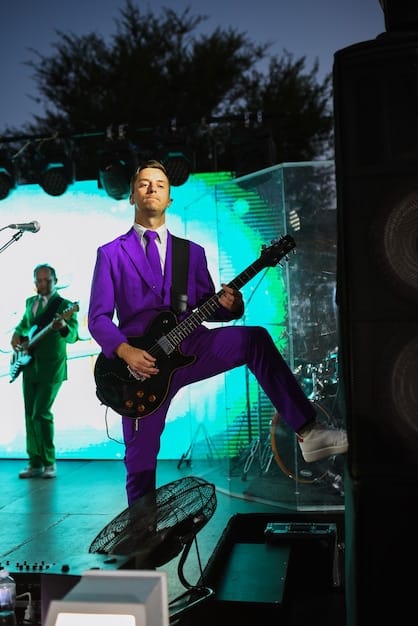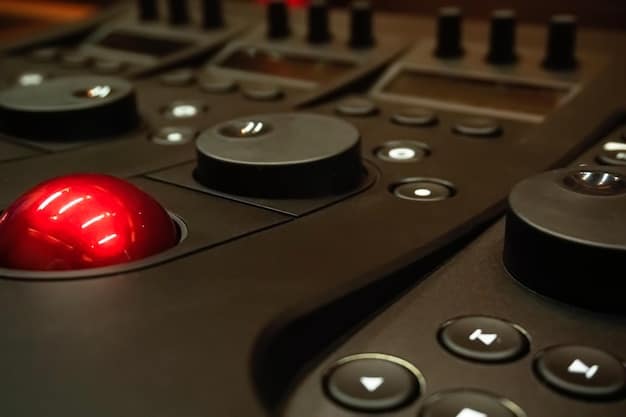The Future of Rock Music: Up-and-Coming Artists’ Insights

The Future of Rock Music: Insights from Interviews with Up-and-Coming Artists, explores evolving sounds, influences, and the perspectives of emerging musicians shaping the genre’s direction in an ever-changing industry.
The future of music is always a hot topic, especially when it comes to genres with rich histories like rock. What will the next generation bring? What sonic landscapes will they explore? This article, The Future of Rock Music: Insights from Interviews with Up-and-Coming Artists, dives deep into these questions. We’ve spoken to a selection of emerging musicians who are actively shaping the sound of rock music as we speak.
Rock’s Evolution: A Constant State of Flux
Rock music, from its rebellious roots in the mid-20th century, has always been an evolving genre. It has absorbed influences, fragmented into subgenres, and reinvented itself countless times. Today, the landscape is as diverse as ever.
Understanding that rock’s strength lies in its ability to morph and adapt, what specific factors are currently influencing its direction? Let’s explore what the artists themselves are saying.
The Blurring of Genre Lines
One significant trend is the blurring of genre lines. Rock is no longer confined to its traditional boundaries, with artists drawing inspiration from various styles.
- Incorporation of Electronic Elements: Many new rock bands are experimenting with synthesizers, drum machines, and other electronic instruments, creating a fusion of rock and electronic music.
- Hip-Hop Influences: The rhythmic complexity and lyrical styles of hip-hop are finding their way into rock music.
- Global Sounds: Rock bands are integrating musical traditions from around the world, resulting in a more diverse and inclusive sound.
This fusion of styles represents a critical phase in rock’s evolution, where traditional boundaries are dissolving to make way for novel, creative forms.
The Influence of Technology on Rock Music
Technology has always played a crucial role in the development of rock music, from the invention of the electric guitar to the rise of digital recording. How is technology shaping the future of the genre now?
The ways music is produced, distributed, and consumed are always changing, influencing the artistic process and bringing about new opportunities.

DIY Production and Distribution
The rise of affordable home recording equipment and online distribution platforms has empowered artists to take control of their music.
This also means greater creative control and financial independence, offering unheard-of possibilities for rising artists.
- Accessibility of Recording Software: User-friendly digital audio workstations (DAWs) have made it possible for anyone to record and produce professional-sounding music at home.
- Direct-to-Fan Platforms: Platforms like Bandcamp and Patreon allow artists to connect directly with their fans, bypassing traditional gatekeepers.
- Social Media Marketing: Social media platforms have become essential tools for promoting music and building an audience.
These tools have leveled the playing field, giving independent artists a fighting chance in a highly competitive industry and allowing for niche genres to flourish.
The Revival of Live Performance
In an age dominated by digital music consumption, live performance has become more important than ever for rock bands.
Live shows offer something that streaming can’t replicate: a sense of community, spontaneity, and shared experience that makes live music so valuable.

Creating Memorable Experiences
Rock bands are increasingly focused on creating memorable live experiences for their fans, going beyond simply playing their songs.
- Interactive Performances: Bands are incorporating elements of audience participation, using technology to create interactive experiences.
- Unique Venue Choices: Rock bands are performing in unconventional locations, such as abandoned buildings, warehouses, and outdoor spaces, adding to the atmosphere of the show.
- Theatrical Elements: Some rock bands are embracing theatrical elements in their live shows, incorporating costumes, stage design, and visual effects.
These immersive shows deepen the connections between the artists and the audience and help sustain the live music scene.
The Role of Social Media in Shaping Modern Rock
Social media plays a critical role in how new rock music is discovered and shared, but its impact goes beyond mere promotion.
Artists are using these channels to engage with fans on a personal level and to harness creativity, transforming the creative process and cultivating a community.
Building Direct Connections
Social media allows artists to communicate directly with their audience, fostering a sense of community and loyalty.
By building direct connections, musicians are able to cultivate authenticity and create a bond with listeners that transcends the conventional artist-fan relationship.
- Live Streams and Q&As: Artists are using live streaming platforms to interact with fans in real time, answering questions and performing impromptu sets.
- Behind-the-Scenes Content: Bands share glimpses into their creative process, offering fans a more intimate look at their world.
- Fan-Generated Content: Artists encourage fans to create their own content inspired by their music, fostering a sense of ownership and involvement.
These features enhance fan engagement and promote mutual support, encouraging a sense of belonging.
The Resurgence of Vinyl and Physical Media
In an era dominated by digital downloads and streaming services, there has been a surprising resurgence of vinyl records and other physical media. Why are people still buying vinyl in 2025?
The tactile experience of holding a record, the ritual of placing it on a turntable, and the warmth of analog sound offer a unique listening experience that digital media cannot replicate.
A Tangible Connection to Music
Vinyl records provide a tangible connection to music that is missing in the digital world.
Furthermore, owning a tangible work of art has become increasingly appealing in an age of immateriality.
- Collecting and Appreciation: Vinyl records have become collector’s items, with fans seeking out rare and limited editions.
- Artwork and Liner Notes: Vinyl albums offer a larger canvas for artwork and liner notes, enhancing the listening experience.
- Supporting Artists: Buying vinyl directly supports artists, providing them with a greater share of the revenue generated by their music.
This renaissance of physical media underscores the perennial human desire to possess and cherish tangible works of art.
Diversity and Inclusivity in the Future of Rock
The rock music scene has historically been dominated by white men. However, the future of rock is looking more diverse and inclusive than ever before.
The inclusion of various voices and viewpoints strengthens rock, making it relevant and resonating for audiences around the world.
Breaking Down Barriers
Emerging artists are challenging traditional stereotypes and breaking down barriers in the rock music industry.
These breakthroughs make rock richer and provide new opportunities for musicians who defy traditional demographics.
- Female Fronted Bands: More women are fronting rock bands and playing lead instruments, challenging the stereotype that rock is a male-dominated genre.
- LGBTQ+ Representation: More LGBTQ+ artists are finding success in rock music, bringing their unique perspectives and experiences to the genre.
- Artists of Color: Artists of color are breaking down racial barriers in rock music, bringing their own cultural influences to the genre.
These improvements are paving the way for a truly inclusive and representative rock scene.
The Power of Collaboration in Modern Rock
Collaboration has always been a part of rock music, but in recent years it has become even more important. Artists of different backgrounds and genres are coming together to create new and exciting sounds. But, how is the act of collaboration influencing innovation?
By pooling their diverse talents, musicians are surpassing conventional boundaries and producing music that is both varied and ground-breaking.
Cross-Genre Partnerships
Rock bands are collaborating with artists from other genres, such as hip-hop, electronic music, and world music, to create new and innovative sounds.
- Breaking Creative Stagnation: Collaborations allow artists to step outside of their comfort zones and experiment with new ideas.
- Expanding Audiences: Collaborations can introduce artists to new audiences, expanding their reach and influence.
- Fostering Creativity: Collaborations can spark new creative ideas and push artists to think outside the box.
By embracing cross-genre partnerships, rock is set to continue on a trajectory of creative discovery.
| Key Point | Brief Description |
|---|---|
| 🎸 Genre Blurring | Rock blends with electronic, hip-hop, and global sounds. |
| 🎧 Tech Influence | DIY production and online platforms empower artists. |
| 🎤 Live Revival | Live shows offer community and unique experiences. |
| 🤝 Collaboration | Artists are partnering across genres for innovation. |
Frequently Asked Questions
▼
The main influences include genre-blurring collaborations with electronic and hip-hop music, the DIY production revolution empowered by technology, and the resurgence of engaging live performances that create communities.
▼
Technology provides accessible recording software, direct-to-fan platforms, and social media marketing, enabling artists to bypass traditional industry gatekeepers and connect directly with their audience.
▼
Live performances offer unique, shared experiences, foster a sense of community, and allow rock bands to create memorable interactions that can’t be replicated through digital streaming.
▼
Social media enables artists to build direct connections with fans, share intimate behind-the-scenes content, and encourage fan-generated content, thus cultivating loyalty and community around their music.
▼
The resurgence of vinyl is linked to its collector’s value, the tangible experience it offers, enhanced album artwork, and its function as a means of directly supporting favorite artists in the digital age.
Conclusion
The future of rock music is poised to be an exciting blend of tradition and innovation. By embracing new technologies, fostering collaboration, and prioritizing diversity, emerging artists are pushing the genre forward and ensuring its continued relevance in the years to come.





